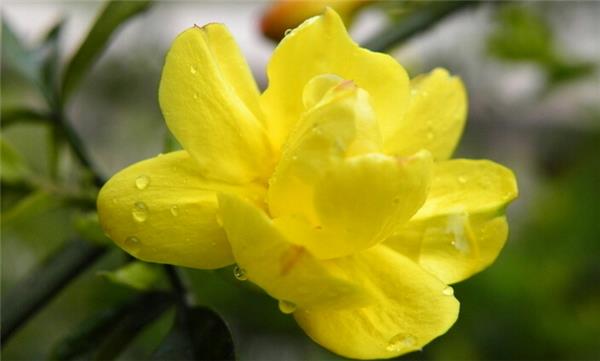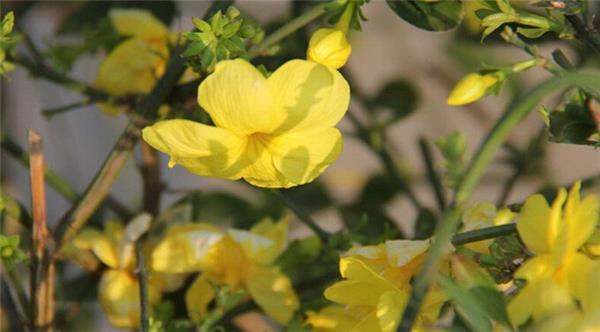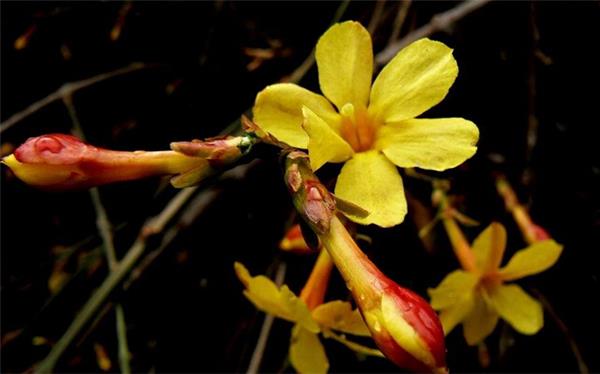When does the primrose bloom? what is the color of the primrose?
Flowers and trees report the season, insects and birds say farming season. In nature, those who are the first to report spring news are primroses and ducks in the water. Let's talk about the flowering time of primrose in detail, so that flower friends can enjoy the flowers.

Flowering time of primrose
Primrose: the flowering time is from February to March every year, the first flower is followed by the leaf, and the flowering period is about 40-50 days.
Wild Yingchun: the florescence is usually in early April, about a month later than primrose, obviously later than plum blossom.
Primrose is named after it blossoms and ushered in spring. It is known as one of the "four friends in the snow". It is juxtaposed with plum blossoms, daffodils and camellia, and is often used as a courtyard plant. So what is the breeding method of primrose?
Culture methods of primrose
1. Soil: the cultivation of primrose has certain requirements for soil, which requires loose, fertile and well-drained sandy soil to grow vigorously in acidic soil and poor in alkaline soil.
2. Temperature: when the summer sun is hot and high temperature occurs, the primrose should be moved to the semi-shady place, which is more beneficial to its growth. Before and after the Spring Festival, move the pot into the greenhouse or plastic greenhouse, keep the room temperature at about 15 ℃, and the flowers can be seen in about 15 days.
3. Watering: Yingchun likes to be moist, watering 1 / 3 times according to the degree of soil dryness and wetness from flowering to flowering, watering frequently before the rainy season, no topdressing in the growing season, and no watering after autumn, in case the branches are too long and too tender to survive the winter safely.

Propagation methods of primrose
Planting primroses is often planted with jasmine. Select 1-year-old branches, cut them into 15cm length, pour water through the whole seedling bed, and then cut them in after water infiltration. After taking root, primrose can be planted separately, and can also be propagated in separate plants or strips.
How to raise primroses
Primroses are mainly planted in oysters, and they can also be propagated by pressing and dividing plants. The longer branches were shallowly buried in the sandy soil without being scratched. They took root after 50 days and were separated and transplanted from the mother plant in the following spring. Ramets can be carried out when buds sprout in spring. When transplanting in spring, part of the aboveground branches should be amputated, and the lodging soil should be brought. In the process of growth, pay attention to the soil can not accumulate water and excessive drought, properly fertilize 2mi 3 times before and after flowering. It should be pruned and reshaped in autumn and winter to keep many new flowers. Leaf spot and branch blight often occur in diseases and insect pests, which can be sprayed with 1500 times of 50% bacilli special wettable powder. Insect pests are harmful to aphids and coir moths, which are sprayed with 1000 times of 50% phoxim EC.
What are the problems that should be paid attention to when raising primroses?
1. Culture environment: Yingchun, which has just been planted or changed, put it in the shade for 10 days after pouring through the water, then go to the semi-sunny place and maintain it for a week, then put it in a place with enough sunshine, good ventilation and moist air for maintenance, and move indoors in winter. If you can't wait to see the primrose early, you can move into the sunny room with higher temperature. After flowering, the flowers can be placed in a relatively low temperature environment to slow down metabolism and prolong the flowering period.

2, regular watering: welcome spring like to be wet, especially in the hot summer, because the water loss rate is fast, every day in the morning and afternoon should be properly watered, but also can sprinkle water to the ground to keep the environment moist, on the contrary in winter. Yingchun is afraid of stagnant water in the basin, in the plum rain season, continuous rainfall, the pot should be moved to a sheltered place.
3. Fertilization: during the spring growing period, it is necessary to apply mature and thin liquid fertilizer once or twice a month. Spring flower bud differentiation period is from July to August, so liquid fertilizer with more phosphorus should be applied to facilitate the formation of flower buds. In the early stage of flowering, the application of dilute organic liquid fertilizer can make the flower color bright and prolong the flowering period.
4. Plastic surgery: the primrose has a strong germinating power. During the growth period, it is necessary to often pick the heart, cut off or cut off some branches in order to maintain the tree shape. After flower withering, the branches should be cut short, generally leaving only 2-3 buds, and the main branches can stay more appropriately.
5. prevention of diseases and insect pests: there are very few diseases and insect pests in the spring, and red spiders occur occasionally, which should be eliminated in time.
Forsythia is also a kind of precious flowers and trees. It blossoms in early spring. The yellow flowers are very brilliant, but they are similar to primroses. Many people do not know how to distinguish them. Here are five tips to tell them apart.

The difference between forsythia and primrose is optimistic about these six points.
The difference between Forsythia suspensa and Primrose: 1. Attribute
Forsythia and jasmine are different in nature. Although both belong to the family Melilidae, Yingchun belongs to jasmine, whose scientific name is Jasminummudiflorum, while Forsythia suspensa belongs to Forsythia, whose scientific name is Forsythiasuspensa (Thunb.) Vahl.
The difference between forsythia and primrose: 2. Petals
The simplest thing is to look at the petals of both. Primrose has six petals, while Forsythia suspensa has only four petals. It is easier to separate the petals when blooming.
The difference between Forsythia suspensa and Primrose: 3. Leaves
Spring leaves all show cross-shaped symmetrical growth, leaves are small, ovate-elliptic, entire, apex narrow and pointed; forsythia leaves ovate, broadly ovate or elliptic-ovate, leaves are larger, and the edges are neatly coarsely serrated except at the base. In addition, Yingchun is three small compound leaves, Forsythia suspensa is a single leaf or three leaves opposite, looking at the growth of leaves can also be observed.
The difference between forsythia and primrose: 4. Branches
Spring twigs are green, forsythia twigs are dark, generally light brown, see the twig color of the two is also a way to distinguish, in addition, spring branches are substantial; forsythia branches are hollow without marrow.

The difference between Forsythia suspensa and Primrose: 5. Fruit
Forsythia is also a kind of medicine, so it usually has fruit, forsythia flowers bear fruit, but primrose rarely bear fruit.
The difference between forsythia and primrose: 6. Tree shape
Yingchun belongs to the jasmine genus of Melilotus family, the plant shape is shrubby, short, the branches are arched and easy to droop; Forsythia suspensa is a genus of Forsythia suspensa, the shape is shrub or tree-like, tall, the branches are not easy to droop, so you can tell the difference between the two by looking at the tree shape.
The flowering time and color of forsythia and primrose are similar, so many people hope to correctly distinguish between the two. The six differences between forsythia and primrose are summarized by Xiaobian, which I believe will help you.
The above is the introduction of the relevant information about primrose, which is introduced by the editor. I hope it can help you understand primrose better.
But Yingchun belongs to jasmine, whose scientific name is Jasminummudiflorum, and Forsythia suspensa belongs to Forsythia, whose scientific name is Forsythiasuspensa (Thunb.) Vahl.
The difference between forsythia and primrose: 2. Petals
The simplest thing is to look at the petals of both. Primrose has six petals, while Forsythia suspensa has only four petals. It is easier to separate the petals when blooming.
The difference between Forsythia suspensa and Primrose: 3. Leaves
Spring leaves all show cross-shaped symmetrical growth, leaves are small, ovate-elliptic, entire, apex narrow and pointed; forsythia leaves ovate, broadly ovate or elliptic-ovate, leaves are larger, and the edges are neatly coarsely serrated except at the base. In addition, Yingchun is three small compound leaves, Forsythia suspensa is a single leaf or three leaves opposite, looking at the growth of leaves can also be observed.
The difference between forsythia and primrose: 4. Branches
Spring twigs are green, forsythia twigs are dark, generally light brown, see the twig color of the two is also a way to distinguish, in addition, spring branches are substantial; forsythia branches are hollow without marrow.

The difference between Forsythia suspensa and Primrose: 5. Fruit
Forsythia is also a kind of medicine, so it usually has fruit, forsythia flowers bear fruit, but primrose rarely bear fruit.
The difference between forsythia and primrose: 6. Tree shape
Yingchun belongs to the jasmine genus of Melilotus family, the plant shape is shrubby, short, the branches are arched and easy to droop; Forsythia suspensa is a genus of Forsythia suspensa, the shape is shrub or tree-like, tall, the branches are not easy to droop, so you can tell the difference between the two by looking at the tree shape.
The flowering time and color of forsythia and primrose are similar, so many people hope to correctly distinguish between the two. The six differences between forsythia and primrose are summarized by Xiaobian, which I believe will help you.
The above is the introduction of the relevant information about primrose, which is introduced by the editor. I hope it can help you understand primrose better.
Related
- Wuhan Hospital Iron Tree Blooming Result Was Instantly Frightened by the Gardener Master
- Which variety of camellia is the most fragrant and best? Which one do you like best?
- What is the small blue coat, the breeding methods and matters needing attention of the succulent plant
- Dormancy time and maintenance management of succulent plants during dormancy
- Minas succulent how to raise, Minas succulent plant pictures
- What are the varieties of winter succulent plants
- How to raise succulent plants in twelve rolls? let's take a look at some experience of breeding twelve rolls.
- Attention should be paid to water control for succulent plants during dormant period (winter and summer)
- Watering experience of twelve rolls of succulent plants
- Techniques for fertilizing succulent plants. An article will let you know how to fertilize succulent plants.



